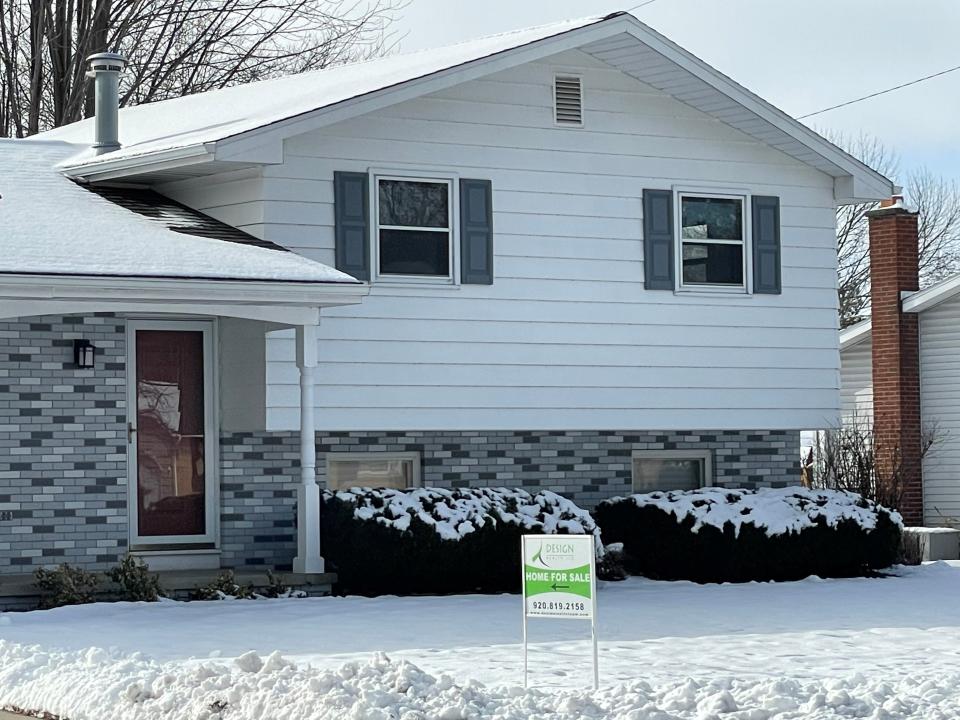Home shopping? Here's what to know if you hope to buy a Wisconsin house this year
GREEN BAY - Homebuyers will want to keep their eyes on two i-words — interest rates and inventory — if they want to stay on top of changes as Wisconsin metro housing markets transition from “competitive to challenging” this year.
The years-long home sales frenzy that gripped most Wisconsin communities subsided in 2022. Buyers and sellers reassessed plans as fixed mortgage rates spiked from 3% to 7%, the volume of homes for sale for less than $300,000 remained critically low, and inflation constrained core household spending.
The result was a double-digit decline in year-over-year home sales statewide, while metro areas' declines ranged from 7% in the Manitowoc County area to 18.9% in the Sheboygan area, with a statewide drop of 14.6%, per Wisconsin Realtors Association data. Median purchase prices continued to increase, though at a slower rate than recent years.
What that means is that buyers in 2023 will have to adjust as the hypercompetitive market of the last six years gives way to one that’s more focused on what each individual household can afford and what's on the market. Dan Ludwig, sales director at Shorewest Realtors' Green Bay office, said aggressive incentives buyers considered, such as inspection waivers and offer acceleration clauses, peaked by summer 2022 and have subsided in many price ranges, though not all.
“(Markets) will change from competitive to challenging,” Ludwig said. “Before it was competitively challenging. Now it’s just going to be challenging because they’ll just have to be able to afford the house.”
Whether buyers are in Wausau and Wauwatosa, Oshkosh and Oconomowoc, they're likely to run into similar market conditions driven primarily by a critical lack of available homes for sale, said Mike Ruzicka, president of the Greater Milwaukee Association of Realtors. He said the demand for homes will likely stay strong for years to come, thanks to a steady stream of qualified, capable younger buyers entering the market and the dearth of available properties statewide.
"There are lots of young people enter the market. There's good demand," Ruzicka said. "We just need more supply to give them."
As the core factors that the housing market change over the year, they will impact buyers’ calculations on what they can afford, ways to save on housing costs, and whether this is the right time to buy. It’s a lot to process, so USA TODAY NETWORK-Wisconsin asked Milwaukee and Northeast Wisconsin-based bankers and real estate professionals to answer some common questions that might give buyers and sellers a little more piece of mind.
Related:More than 300 housing units to be developed in the Fox Cities over the next year
What does the mortgage rate actually add to my monthly payment?
The 30-year fixed rate mortgage average has dropped down to about 6.1% now from its October peak of 7.1%.
Buyers had to recalculate how much home they could afford as rates rose, and, now, as they fall.
The key calculation buyers should know is that a 1% increase in your rate generates about $48 per month in interest per $100,000 borrowed, said Tom Zellner, Nicolet National Bank’s senior vice president and mortgage director. A 1% increase on the average priced, $240,000 home translates to an extra $125 to $150 in monthly interest, Zellner said.
Zellner suggested buyers stay in close contact with their lender so they have the most current information as they shop.
“Constant communication with your banker is vitally important to limit the surprises when you finally get your offer accepted on your dream home,” Zellner said.
Is now a good time to buy a home?
Milly Saldarriaga, a real estate agent with Shorewest in Green Bay, said families frequently ask her this big question as they weigh so many factors.
It’s a concern she understands: It’s a big purchase. There’s a lot of dollars at stake. And a home is the American dream.
Ultimately, she said agents cannot make that decision for their clients, but they can help them work through key questions like what they're paying for rent now, if they need more space, what they can afford. She said many feel the stress of trying to find a home they can afford, with enough room for their growing family.
"They keep looking," Saldarriaga said. "They say the house is going to come, but it's challenging. It's a competitive market for them."
Should I wait for mortgage rates to return to the 3% range?
"I don't think we're going to go back to those days," Ruzicka said.
The growing consensus, though by no means guaranteed, is the 30-year fixed mortgage rate will settle in somewhere between 5.5% and 6.5%, a range expected to become the new normal, said Michael Sewell, of the Realtors Association of Northeast Wisconsin. It’s not the 10-14% mortgage rates of 40 or 50 years ago, nor the recent, historic lows, he said, adding consumers will adapt.
“People still bought and sold homes when interest rates were in double digits because they had to,” Sewell said. “We’re adjusting now to 6.5%, 6% and 5.5% now and those are still historically good rates. We might not see 3% again, but 5.5% is still a good interest rate.”
Ruzicka said the shock of last year's rate spike will wear off and buyers will adjust to the current rates.
"The range right now is historically good," Ruzicka said.
Is an adjustable rate mortgage (ARM) worth it?
Rising fixed rates led to a resurgence of interest in adjustable rate mortgages, or ARMs, as a way to save some extra dollars on interest costs.
An ARM offers buyers a slightly-lower interest rate, but one that's set only for the first five or seven years. After that, the interest rate can go up within annual and lifetime limits set out in the loans terms. But as quickly as they became popular in 2022, Northeast Wisconsin bid a farewell to ARMs.
“When (fixed) rates went up to 7%, ARMs were the hottest thing ever to counteract higher interest rates,” Zellner said. “Today, the rate environment came back down again and the 30-year rate is more attractive.”
Zellner said an ARM could be the right solution for a buyer who expects to sell the home in five or seven years, but not for a family that just found their forever home. Ludwig said those who do choose an adjustable rate can always refinance ahead of any potential rate adjustments.
"We say 'marry the home, date the rate,'" Ludwig said. "Get into a house now; the rate can be handled later."

Any chance more homes will hit the market?
Maybe. It’s all a matter of how homeowners view the market.
Last year’s spike in mortgage rates changed current homeowners’ thinking about whether to move up to a bigger home. Homes were already in short supply, plus a low interest rate can be hard to let go of.
“When people are locked in at 3%, what incentivizes them to buy at 6%?” Zellner asked.
Sewell said he expects rates in the 5.5-6.5% range will “loosen up” inventory, a measure of how many homes are for sale at any given time. With stable rates, more home owners might decide to sell their current homes in the process, ideally increasing the number of homes for sale at key price points, like below $300,000.
“I think we might get a little bit of a trickle down to help the entry level people coming in (to the market),” Sewell said.
Ludwig, at Shorewest, is concerned any inventory relief from lower mortgage rates will be minimal, especially in the severely-depleted $100,000 to $300,000 price range, a key segment affordable to most Wisconsin homebuyers. Green Bay, for example, has teetered around one month of inventory in the $100,000 to $300,000 price range, when Realtors say a normal or “healthy” level of inventory equals six months of sales.
Real estate searches highlight the shortage of options buyers encounter. A search for a two-bedroom, two-bathroom house between $100,000 and $300,000 produces 19 listings in Sheboygan, 25 in Wausau, 58 in Green Bay, 22 in Appleton and 239 in Milwaukee.
Ludwig said it will take a lot of new buyers listing their homes to move the inventory needle.
“Nothing is really going to help us here,” Ludwig said. “Even if they lower interest rates, it’s not going to help the market, just put us back in that competitive state.”
Will property values drop?
Buyers who have bought homes in recent years might harbor concerns the decline in home sales might mean their home’s value will decline.
The consensus is they need not worry.
"Real estate will be solid for the rest of the decade just because of the demographics," Ruzicka said.
On the lending side, Zellner said there’s a lot of preapproved buyers in the pipeline and demand remains strong, both indicators homes should hold their value. Plus, he said foreclosures, which can push values down, have increased but remain in expected ranges.
Sewell said most properties also will hold their value because demand remains strong amid a short supply of homes for sale.
“There’s always extremes, but for the most part, the market’s going to remain pretty stable,” Sewell said.
Will house prices go up?
Probably, but not the double-digit increases common for the last six years.
Realtors expect the sheer demand for housing will keep home prices up, but also said buyers should change how they think about sellers’ list prices. In past years, buyers who wanted any chance at a sale had to search for homes with a list price that left room for them to bid up from there.
“It used to be negotiations started at the list price and went up. Now, the ending negotiation price is right around the list price,” Saldarriaga said.
Sewell said the ratio of the listing price to sell price has returned to the 95-98% range, an indicator that buyers can expand their price range a little further.
“The list price was the starting price,” Sewell said. “Now, it’s the price-price.”

Did you ask about down payment assistance?
Sewell said buyers concerned with affordability can adjust their monthly payments in other ways, too. They might look at communities with lower property taxes or insurance rates.
“Look at the whole picture, not just interest rates,” he said. “Maybe I change where I’m looking. Maybe one area has lower taxes and insurance. Sit down with your Realtor, sit down with your lender and figure out where you’re going.”
Zellner also encouraged homebuyers to ask lenders, local housing agencies, their employers and local governments if they offer homebuyers any help. Down payment assistance programs have started to crop up as communities look to address one of the major impediments to home ownership buyers cite.
For example, Green Bay community leaders recently launched a program to offer up to $10,000 in down payment assistance to homebuyers who work at select Green Bay employers and nonprofits and purchase a home in the city.
Sewell said potential buyers should always ask.
“Depending on income levels, property locations, they might qualify (for assistance),” Sewell said. “There are so many great programs out there, a buyer needs to talk with their lender about what options fit their needs.”
Contact Jeff Bollier at (920) 431-8387 or jbollier@gannett.com. Follow him on Twitter at @JeffBollier.

CONTINUE YOUR SUPPORT: Thanks to our subscribers for making this coverage possible. Be sure to download our app on the App Store or Google Play. Follow us on social media: Facebook | Twitter | Instagram | Newsletters
This article originally appeared on Green Bay Press-Gazette: Wisconsin housing market: Frenzy subsiding, but inventory still low

